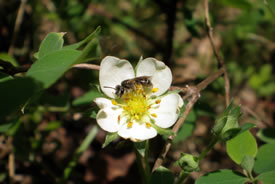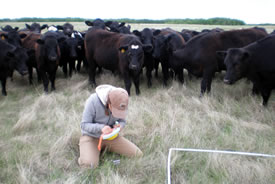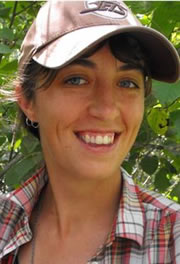Pollinator edge effects on Manitoba's grasslands

A small andrenid bee sheltering in a wild strawberry flower (Photo by Marika Olynyk)
Animal pollination is a key ecological process, ensuring the reproduction and genetic diversity of most flowering plants, and providing food for pollinators. In Manitoba, insects are the most important pollinators. Our short summers are busy as flies, bees, butterflies and moths visit flowers of all kinds. From a conservation perspective it is often easy to focus on the needs of large, charismatic animals, but insects and the ecosystem processes that they support are just as important and often less well understood.
In Manitoba, over 75 percent of our original grasslands have been lost, and the remaining grassland areas are highly fragmented, broken up by roads, crops, and tree and shrub encroachment. This fragmentation creates "edge effects,” which are the changes to ecological communities that occur near the boundary of two habitats.
I wanted to find out if there are edge effects on insect pollinators and plant pollination in Manitoba grasslands. As a master’s student with the Natural Resources Institute at the University of Manitoba, I received support from the Nature Conservancy of Canada's (NCCs) Science Support Program and access to NCC conservation lands to help answer this question.

Curious cows look on as the team works (Photo courtesy of Marika Olynyk)
With my assistant, Vanessa Comeau, I spent the summer collecting data in western Manitoba on grassland sites with woody and road edges. Our work this summer included vegetation surveys and pollinator surveys, using coloured water-filled bowl traps which the insects mistake for flowers.
The cattle grazing in our fields also found our bowl traps to be attractive, and we had to use some portable fencing once they got too curious! We also brought greenhouse-grown plants out to the fields for exposure to insect pollinators, before returning them to the greenhouse. By counting the seeds they produced, we will be able to see how well they were pollinated in different areas.
Since completing the fieldwork this summer, I have been working to identify the pollinators we collected, and to conduct analyses to find out if edge effects are occurring and in what way. Once my results are in, I’ll share them with NCC and others interested in grassland conservation. Hopefully they will help guide our understanding of how landscape changes affect pollination and how we can best manage for the conservation of wild pollinators.


